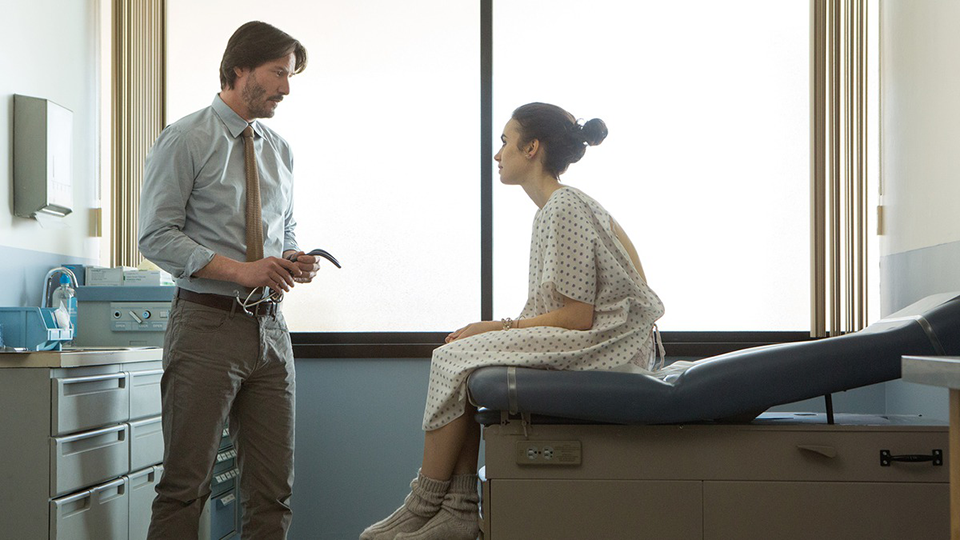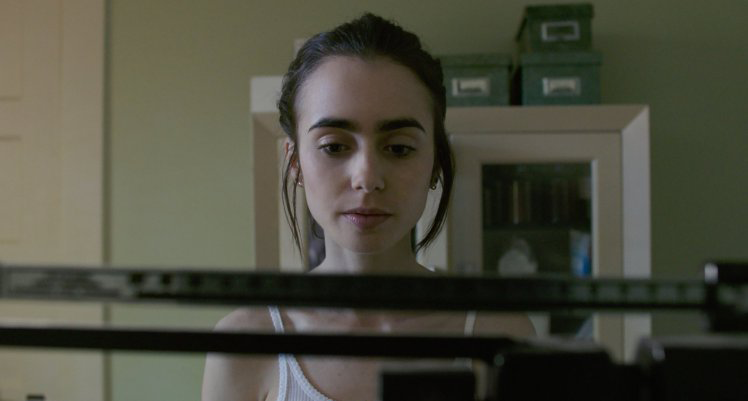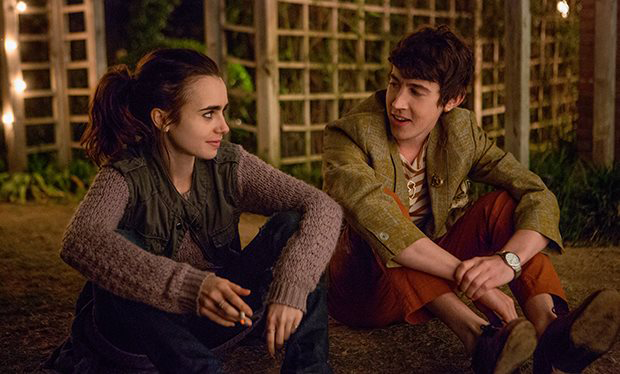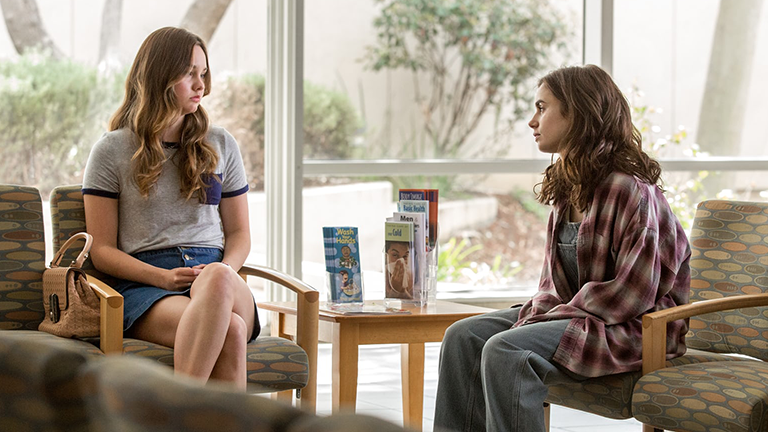New Netflix film To the Bone is causing controversy for promoting eating disorders – we spoke to experts and sufferers to find out the impact of seeing anorexia on screen
‘Cassie from TV series Skins was my generation’s anorexic role model,’ admitted 25-year-old business consultant *Lucy (not her real name). ‘She taught me and my friends how to make it look like we were eating our dinners and she taught me to smoke to suppress my appetite – which I started doing from the age of about 14.’ Using cigarettes as a meal replacement, Lucy used to steal from the local corner shop because she was so afraid of her parents finding her receipts.
There will always be a voice in her head telling her that she’ll feel a little bit better if she were to lose weight
In the light of Marti Noxon’s new Netflix film, To the Bone, which portrays 20 year old called Ellen ( played by Lily Collins) who is placed within an unconventional treatment facility and treated by Dr William Beckham (Keanu Reeves), the debate about eating disorders onscreen has surfaced once again. Both director and screenwriter Marti Noxon and star Lily Collins have suffered from anorexia in the past and worked alongside a charity called Project Heal to ensure that the film wouldn’t become exploitative.
More harm than good?
It’s clear that the film is well intentioned, but could it be doing more harm than good? People certainly seem to think so and a petition has even kicked off online demanding the show be taken down from Netflix where the film is described as glamorising anorexia and a ‘gross misjudgement’.

Deanne Jade, psychologist and founder of the National Centre of Eating Disorders has a few concerns about the new film, most of which revolve around the casting of Lily Collins and her decision to lose weight to portray Ellen, her anorexic character. ‘An ex-sufferer is slimming down again to make this film,’ says Jade. ‘It’s incredibly dangerous and frankly, I’m disgusted by it… eating disorders are relapsing conditions.’ She suggests that the process of filmmaking might prove stressful and could make the weight-loss feel appealing for a recovered Collins. ‘It’s a dangerous thing to do – for a young woman that has spent a long time trying to recover. There will always be a voice in her head telling her that she’ll feel a little bit better if she were to lose weight.’
You don’t need to be size 0 and have ribs sticking out to have an eating disorder
This is by no means the first time we’ve seen eating disorders on screen, though in the past they’ve not usually been played by recovered anorexics. Some critics suggest that when eating disorders are shown on television and in films the problem starts with the unrealistic way they are often portrayed.
An unrealistic portrayal?
As a recovering bulimic and anorexic, Lucy revealed that she feels representations of eating disorders on screen are often unrealistic and this can impact people’s perceptions. ‘These shows don’t tend to portray the disorder as it truly is. Most people with eating disorders suffer from some other form of mental illness and you don’t see that side of it – the anxiety, the depression… I also struggle with the typical portrayal of a person with an eating disorder. You don’t need to be size 0 and have ribs sticking out to have an eating disorder.’
Lucy remembers a time when she was at her worst and a friend told her she was looking extremely thin. When she confided in this friend about her condition she was told ‘You’re thin but you’re not thin enough to have an eating disorder.’ Lucy admitted, ‘It sounds sick but I was so excited to tell someone about not eating, I was proud. When she didn’t notice I embarked on the cotton wool diet which is where you eat cotton wool soaked with juice instead of eating food, to keep you full.’
Recovering anorexic Amalie Lee has an Instagram account that has garnered a following of 110 thousand people and no wonder – it’s littered with booty pics, pizza and body positive posts. Like Lucy, Lee worries that the stereotypical eating disorder type that is shown on screen could be damaging for sufferers. ‘It’s usually a young, Caucasian, apple-eating female with restrictive behaviours and protruding collar bones. When we’re constantly faced with this false image of what an eating disorder looks like without anyone challenging it, we absorb it. That means we might fail to detect eating disorders occurring in people that don’t fit this stereotype… some people might not even realise they have an eating disorder as they could think, ‘this doesn’t happen to people of my gender/age/size/ethnicity/ability’ and this could hinder recovery.’ In Noxon’s film all of the anorexia patients, with one male exception, are young, attractive, middle-class white women.
When we’re constantly faced with this false image of an eating disorder, we absorb it.
Psychologist Deanne Jane seems less concerned with this portrayal. ‘If they have to choose someone to play an anorexic, they’re going to use a stereotype… statistically not all, but most anorexics are young, white adolescent girls. I don’t think films should have to be politically correct because that’s just the truth.’
However while representing an average anorexic profile, Jane has worries that To the Bone’s edgy, cool-girl Ellen with her kohl eyes and attitude problem doesn’t quite represent the harsh reality of anorexia. ‘In two out of five cases there is a very unhappy ending to this illness – death. There’s also a high chance of suicide among those with anorexia with a rate 57 times higher than average at any given age.’ Insta-star Lee adds that while it’s impossible to portray an eating disorder on screen in an entirely trigger-free way she says that it’s important to be mindful ‘not to romanticise the condition as something cool and quirky.’
Triggering eating disorders
Clinical psychologist Dr Bryony Bamford explained that particularly for people with Anorexia, seeing the disorder displayed on screen could have a detrimental effect on recovery. ‘Anorexia nervosa, in particular, can be a highly competitive illness and the portrayal of particular behaviours around food could play a part in shaping and exacerbating illness.’ She adds that the media have a difficult job trying to get things right. ‘Accurate portrayal of a serious eating disorder may contribute to denial or minimisation of a person’s own disorder, whilst misrepresentation or glamourisation can also be extremely dangerous.’

Lucy worries that the experience she had with Skins character Cassie, will continue to happen to people with eating disorders when they see ‘cool’ depictions of anorexic people onscreen, such as that of Ellen in To The Bone. ‘I went to an all-girls school and I remember how we would want to be like Cassie. You’re aspiring to be ill which is just so strange… I don’t think its right to eliminate all on-screen performances of this kind but maybe we should control the amount of information we give to people on how to do it – I learned how to cut up my food to look as though it had been eaten and the best way to be sick. It’s very explicit and really has the power to affect people.’
when you are sick it can feel like you’ll never be able to eat normally, never love your body and never feel healthy
Eating disorder specialist Jade agrees with Dr Bamford that the competitive side to this illness is part of what causes these triggers and adds ‘there are high levels of autism among people with anorexia and also narcissistic personality disorder where they have a compulsion to feel special. If they don’t feel that they’re special they feel worthless. People with anorexia often also hear voices and these are things that the general public don’t understand that you often don’t see onscreen.’ She also has worries that people will see films like To the Bone and try and copy the behaviour of characters.

Isabelle Mulkerrins runs a blog called Life Without Anorexia. Suffering from cystic fibrosis she looked for an aspect of her life she could control and her weight plummeted to just six stone four pounds, giving her a BMI of 13. When she was sick and in hospital she would look at media (mostly recovery and ‘thinspo’ YouTube videos) and found it extremely triggering. ‘It led me to compare myself to others, I felt like I wasn’t skinny enough or sick enough to be in hospital and so that really had a negative impact on me.’ Mulkerrins explained how it feels to be in that state, ‘when you are sick it can feel like you’ll never be able to eat normally, never love your body and never feel healthy.’ Jane explained that films do very little to reduce stigma because most people can’t fully understand being in this state of mind. ‘It’s a very illogical condition when someone screams that they’re fat when they’re the very opposite.’
Raising awareness
It’s not all bad. Dr Bamford, who is the clinical director of The London Centre for Eating Disorders and Body Image sees a positive in any depiction of these conditions onscreen. ‘The presentation of eating disorders within the media is, for the most part, a positive thing,’ she explained. ‘Eating disorders have been heavily underreported over the years… the accurate portrayal of eating disorders can also help motivate people to seek support either for themselves or for someone they are concerned about.’
If they were made in a more intersectional and conscious manner, they could be highly beneficial
Film director Marti Noxon has explained that she was moved to create the film for this purpose, ‘I hope by casting a little light into the darkness of this disease we can achieve greater understanding and guide people to help if they need it,’ she wrote on Twitter. While acknowledging the dangers, Blogger Mulkerrins feels that films like this have their uses, ‘I think they’re educational for people who don’t suffer and who don’t really know what an eating disorder is.’ Lee adds that these films have the potential to raise awareness but that the approach is all wrong. ‘If they were made in a more intersectional and conscious manner, they could be highly beneficial but as long as the aim is to profit and entertain rather than to help and inform I doubt this will be the result.’

To the Bone has received its fair share of both praise and criticism, it seems that for someone with an eating disorder, navigating life without hitting a trigger is never an easy feat. For some, this film brings awareness to a stigmatised cause and for others, it is a dangerous tool used by sufferers. But let’s not forget, eating disorders manifest from a multitude of below-the-surface issues. ‘Eating disorders have a very complex set of risk factors, they’re not caused by movies,’ concludes Jane.
Read more
My clean eating became orthorexia nervosa
Is your Instagram making you ill?
Does yoga encourage eating disorders?
How to spot an eating disorder at work
Like this article? Sign up to our newsletter to get more articles like this delivered straight to your inbox.





















































